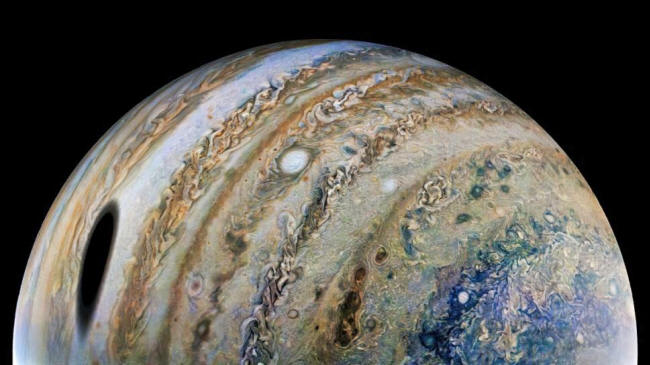|
of Jupiter during a flyby on April 9, 2022. Image credit: Image data: NASA/JPL-Caltech/SwRI/MSSS Image processing by AndreaLuck © CC BY
This was Juno's 41st flyby above the radiation-spewing planet, during which the spacecraft soared at a top speed of 131,000 mph (210,000 km/h) relative to Jupiter.
That's more than seven times faster than the speed of the International Space Station orbits Earth and about five times faster than the crewed Apollo missions were traveling as they left Earth for the moon, NASA officials said in the statement.
The colorful imagery was created from the JunoCam instrument's raw images, which officials upload to an image processing gallery that allows citizen scientists to add their insights to the raw data.
While Juno's initial main target has been Jupiter, in January 2021 NASA authorized an extension of the mission's mandate to focus a little more closely on the planet's four large moons, especially, Juno will run until September 2025, assuming it remains in good health.
Radiation will likely be the mission's main threat as it attempts to continue its work for the next three years, but as long as Juno is active, it will serve as a scout for future missions at Jupiter, the largest planet in the solar system.
NASA's Juno spacecraft imaged Jupiter and Ganymede's shadow during the mission's 40th close pass by the giant planet on Feb. 25, 2022. Image credit: Image data: NASA/JPL-Caltech/SwRI/MSSS Image processing by Thomas Thomopoulos © CC BY--
In the 2030s, for example, NASA's Europa Clipper and the European Space Agency's JUICE mission (Jupiter Icy Moons Explorer) plan to visit Jupiter moons directly.
The new James Webb Space Telescope will also examine the giant planet from afar during its forthcoming Cycle 1 set of observations. Webb's work will add to years of data collected under the Hubble Space Telescope's Outer Planet Atmospheres Legacy program, which seeks to study the gas giants of the solar system at least once every Earth year.
|



